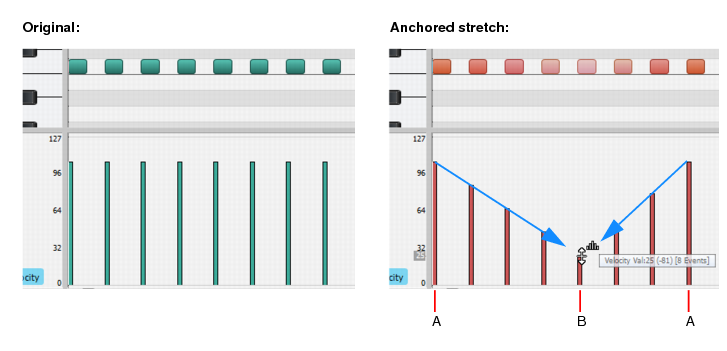
, position the pointer near the top center of the note, then drag up/down.

, position the pointer near the top center of the note, then drag up/down.

, position the pointer near the top center of any selected note, then hold down the SHIFT key and drag up/down.

, position the pointer near the top center of the note, then hold down the SHIFT key and drag up/down.

, position the pointer near the top center of any selected note, then hold down the CTRL key and drag up/down.

, position the pointer near the top center of the note, then hold down the CTRL key and drag up/down.
A. First and last selected velocity lines remain stationary B. Hold down the CTRL key and drag any selected velocity; all other selected velocities ramp toward the dragged velocity line

, position the pointer over the note’s start or end point, then drag left/right to adjust the start/end position.

, position the pointer over the note’s start or end point, then drag left/right to adjust the start/end position.

, drag with the right mouse button over the notes you want to select.

, position the pointer over the bottom half center of the note, then click to select the note.

, click the note.

, drag over the notes you want to select.

, hold down the SHIFT key and right-click the note.

, click the note to mute/unmute a single note, or drag over notes to mute/unmute multiple notes.

, position the pointer over the bottom half center of the note, then drag the note to the desired location.

, drag the note or selection to the desired location.

, click where you want to insert a new note. Before releasing mouse button, drag left/right to change duration, and up/down to change pitch.
, position the pointer over a selected note and drag up/down to quantize all selected notes.

, hold down ALT+CTRL and drag across two or more notes of the same pitch (click on the first note, drag to the second note and release the mouse button).

, hold down ALT+CTRL and drag to insert multiple notes. Use the Value control to specify the duration of each note, and use the Snap resolution to specify the interval between each note.

, drag to insert multiple notes. Use the Value control to specify the duration of each note, and use the Snap resolution to specify the interval between each note.

, locate and select the pattern you want to paint. The selection can be a clip, a portion of a clip, MIDI events in the Piano Roll view, or a MIDI loop in the Media Browser. To select MIDI notes in the Piano Roll, drag with the right mouse button over the notes you want to select. Drag from left to right in the Piano Roll view or Track view to “paint” the selected data. When painting with the Pattern tool, the mouse pointer looks like a paint roller:
. For details, see Pattern tool.

, right-click a note to erase a single note, or keep the right mouse button pressed and drag over notes to erase multiple notes.

, click a note to erase a single note, or drag over notes to erase multiple notes.

, position the pointer where you want to split the note, then hold down ALT and click (or lasso to split a region).

, position the pointer where you want to split the note, then click (or lasso to split a region).
or S keyboard shortcut, MIDI notes that overlap the split position will also be split, and MIDI chase events (such as continuous controllers, Pitch Wheel, and Patch Change) are inserted at the split position. You can enable/disable this behavior with the Split MIDI Notes option in Edit > Preferences > Customization - Editing (see Customization - Editing (Advanced)).
, double-click the note.

, hold down the CTRL key and drag the end of any selected note.

, hold down the SHIFT key and drag the end of any selected note.
, hold down the ALT key and right-click any selected note.
, hold down CTRL+ALT and right-click any selected note.
Tip - Searching Documentation
Tip: To search for a specific topic, type your search query in the Search Cakewalk.com field at the top right of this page.
When the search results appear, click which product's documentation you would like to search to filter the search results further.
Note - Using Offline Help
Note: If you prefer to always use offline Help, go to Edit > Preferences > File > Advanced in your Cakewalk software and select Always Use Offline Help.
If you are not connected to the internet, your Cakewalk software will default to showing offline help until an internet connection becomes available.




